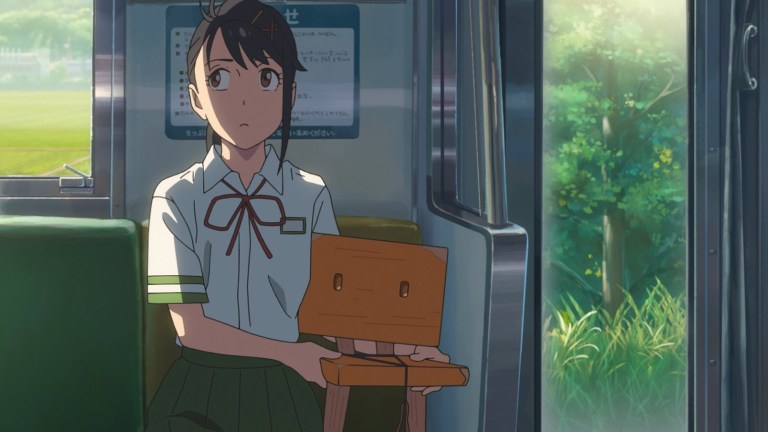How Suzume Was Inspired by RPG Boss Battles
Makoto Shinkai talks about the inspirations and challenges behind his latest anime masterpiece, Suzume.

Makoto Shinkai is a revered name in animation who’s emerged as someone who expertly combines melodramatic love stories with fantastical explorations of nature and what it means to be human. Garden of Words, Your Name, and Weathering With You are some of Shinkai’s most celebrated feature films that helped establish the writer/director as a force to be reckoned with and must-see cinematic events. Shinkai’s latest feature, Suzume, has been more than four years in the making and it looks at a listless 17-year-old who finds herself on an unexpected mission to protect Japan from paranormally-influenced natural disasters alongside a very unconventional guide.
Suzume has found heavy critical acclaim and it’s already become the eighth-highest-grossing anime film of all time in Japan as well as the country’s 14th highest-grossing film, period. In honor of Suzume’s wide theatrical release, Makoto Shinkai (via an interpreter) opens up on the film’s real-life inspirations, why Sota had to turn into a chair of all things, and if we’ll ever see more of the Suzume universe.
Den of Geek: Natural disasters and environmental concerns are a running theme through your filmography and Suzume deals with earthquakes and tsunamis. Why did you want to highlight that in this movie and why has this subject continued to fascinate you?
Makoto Shinkai: With respect to the most recent three films that I’ve directed, disasters are certainly a main theme in all of them. However, in no case did I set out to tell a story about disasters. Looking at Suzume specifically, I wanted to tell this adventure that’s set throughout modern-day Japan. As I started to plot out and develop this story, the idea of disasters continued to creep in. I think that’s partly because you cannot look at current Japan without acknowledging the fact that these disasters have happened. With Suzume, the character, the 2011 Tōhoku earthquake becomes a huge part of her journey. Part of that is because I feel like we live side-by-side with disaster and that it can strike at any moment. The movie is about that coexistence.
One of my favorite sequences in this movie is the door-closing setpiece that occurs on the abandoned roller coaster. How did you decide on that setting and was it a challenging sequence to storyboard and choreograph?
First, since Suzume is a bit of a “road movie,” I wanted Suzume to travel through different ruins. When thinking about why she needs to travel through ruins–looking at Japan right now–there are several areas that have been deserted and turned into ruins; some by natural disasters and others by human influence. I felt the door in Suzume could be a very strong symbol to represent these ruins. I wanted whatever our protagonist was doing to represent some kind of action. This act of closing the door, in different types of ruins, is a representation of Suzume’s journey and the unique doors that she needs to close.
Now, to go back to the action sequence at the amusement park and how that came to be, as Suzume travels through these unique locations she always needs to fight these worms. In some ways, to help keep the younger audiences engaged, I almost thought of these encounters like boss battles in RPGs. When Suzume makes it to the amusement park–and I know that it’s a very long sequence–to have a lot of dynamic movement. We had to re-board it many times before we got the action just right.
This particular scene in the abandoned amusement park is of course a reference to the many real abandoned amusement parks in Japan. The one in Suzume is fictional, but I referenced several real amusement parks for this sequence. It’s a lot of fun to imagine the type of action that you can accomplish with roller coasters, ferris wheels, and more. We explored a lot of possibilities there and it was a fun process for us.
I really love that Sota turns into a chair and becomes this unusual sidekick, but why did you decide upon a chair and did you ever consider any other inanimate objects?
First and foremost, the 2011 earthquake was a huge backdrop for this film and had we depicted that in a very straightforward manner then I think that would have resulted in a very dark and depressing film. I wanted something to kind of offset and contrast against that, when it comes to Suzume’s sidekick. The chair itself as Suzume’s sidekick came down to figuring out what kind of cute object could we use to invoke that. Looking at a chair in its normal state, it has four legs, which makes it easier to equate to a cat or a dog. For those reasons, I could envision a chair moving in animation. However, if it did have four legs and was running around normally–like a dog–I think that would slightly take away from the character’s awkward nature. I decided to give the chair three legs, which results in very unique movement and animation. Just looking at Sota walk around invokes a lighter mode that really brightens the film.
This film has an exceptional cast with a lot of newcomers to anime voice acting, including the debut of Ann Yamane, the young actress who provides the voice for Daijin. How did you come to the conclusion that the character should be voiced by a child, as well as discovering this emerging talent?
With Daijin’s voice actor, I believe she was seven years old, and I didn’t go out seeking that particular cast for the role. Rather, we were in the process of casting Young Suzume, which resulted in a lot of auditions. Ann Yamane was one of our Young Suzume auditions and she had a very unique voice, which didn’t quite work for Young Suzume. However, I kept listening to it and it seemed like it’d be such a good fit for Daijin. So we discovered her through that audition process.
There’s this certain tension between Daijin and Suzume where Daijin wants to become Suzume’s child. I feel like that mother/child–parental–relationship is a very strong central theme in Suzume. Of course, Suzume has her relationship with her own mother, who passed away, but also Tamaki who took her in. Suzume and Daijin have a similar parental relationship that echoes this. I wanted Daijin to invoke that child-like quality to better contrast with Suzume’s role, where she’s almost a mother figure in this case. It made a lot of sense to have a young child voice that role when thinking about Daijin’s voice.
Suzume is playing in select U.S., U.K., and Canada theaters on April 14th, in both subtitled and English dubbed versions.
